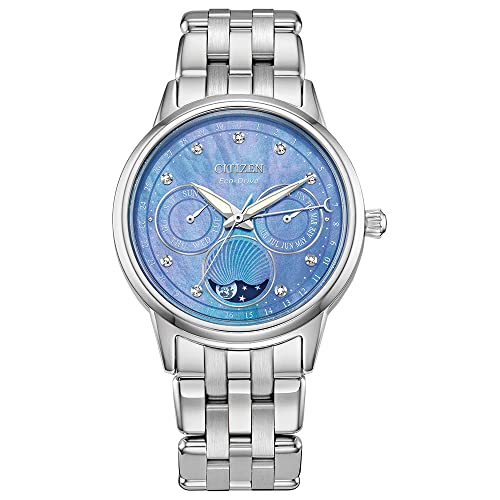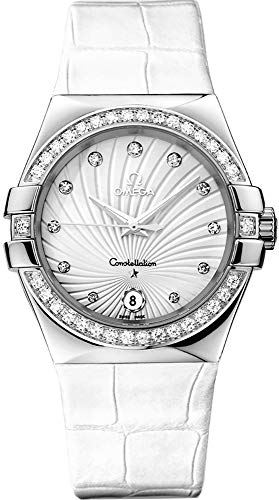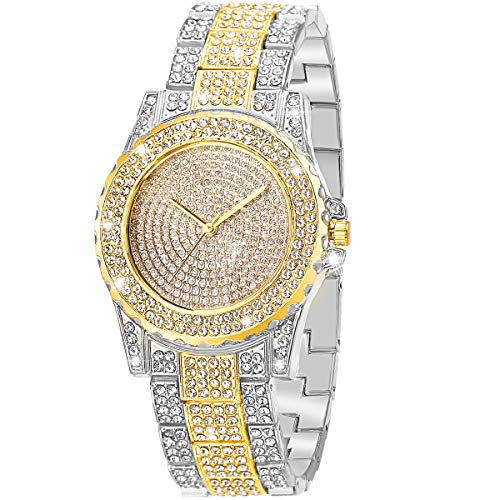This step-by-step guide helps readers identify the quality of diamond-encrusted watches, providing valuable information for watch enthusiasts and potential buyers. By following the steps, readers can make informed decisions and invest in high-quality timepieces.
Step 1: Evaluate the Clarity of Diamonds
Examine the diamonds closely, focusing on identifying any visible flaws or inclusions. Hold the diamond-encrusted watch under a source of bright light, such as a lamp or a flashlight, to enhance visibility. Inspect each diamond individually to ensure a thorough evaluation.
1. Look for any blemishes or imperfections on the surface of the diamonds. Imperfections can include scratches, pits, or chips. Rotate the watch and observe the diamonds from different angles, checking for any irregularities that may compromise the clarity.
2. Identify any visible inclusions within the diamonds. Inclusions are internal flaws that can affect the transparency and brilliance. These may appear as dark spots, cloudiness, or even small cracks. Use a jeweler’s loupe, which is a small magnifying device, to examine the diamonds closely and detect any inclusions that may be difficult to see with the naked eye.
3. Note the overall clarity of the diamonds. High-quality diamonds have excellent clarity, with minimal to no visible imperfections. If you observe diamonds with exceptional clarity, they will appear clear and brilliant even under different lighting conditions.
By following these steps, you can effectively evaluate the clarity of the diamonds in a diamond-encrusted watch. This initial assessment will assist you in forming an accurate judgment about the overall quality and value of the timepiece.
Step 2: Assess the Cut of Diamonds
Assessing the cut of diamonds is an essential step in determining their quality and value. To begin, examine how the diamond reflects light, as a well-cut diamond will have superior brilliance and sparkle. Follow these steps to evaluate the cut of the diamonds:
- Look for precise and symmetrical cuts: A diamond with precise angles and proportions allows light to enter and exit the stone efficiently, maximizing its beauty. Inspect the diamond carefully for any irregularities or asymmetry. For example, examine the facets on the diamond to ensure they are evenly shaped and symmetrical.
- Check for brightness and fire: Hold the diamond under various lighting conditions and observe how it interacts with the light. A well-cut diamond will reflect a significant amount of light back to the viewer, creating a bright, sparkling appearance. Look for flashes of white and colored light known as “fire,” which are signs of a well-cut diamond.
- Consider the diamond’s proportions: The proportions and ratios of a diamond impact how light is refracted and dispersed within the stone. Each diamond shape has specific guidelines for optimal proportions. For instance, a round diamond should have a depth between 58% and 62%, with a table diameter ranging from 53% to 64%. Consult a reputable diamond grading system or expert to understand the ideal proportions for your chosen diamond shape.
- Pay attention to the diamond’s overall beauty: While a well-cut diamond excels in brilliance and sparkle, consider how it appeals to your personal taste. Some individuals prefer diamonds with more fire, while others value a balance of brightness and fire. Your preference will play a crucial role in the final decision.
By assessing the cut of diamonds through careful observation of their reflection, symmetry, brightness, and proportions, you will be able to identify diamonds of higher quality, ultimately guiding your buying decision. Keep in mind that diamond cuts can vary, so familiarize yourself with different styles and seek professional advice if needed.
Step 3: Examine the Color of Diamonds
The color of diamonds can vary greatly, and it is important to understand that higher-quality diamonds tend to have less color. When examining a diamond’s color, look for those that are colorless or near colorless, as these are generally considered to be of higher quality. Here are some key points to consider when evaluating the color of diamonds:
- Understand the color scale: Diamonds are graded on a color scale that ranges from D (colorless) to Z (strongly yellow or brown). The closer a diamond is to the D end of the scale, the more valuable it tends to be.
- Look for clear diamonds: Aim for diamonds that appear colorless or near colorless to the naked eye. These diamonds will have less yellow or brown tint and will have more sparkle and brilliance.
- Observe diamonds in different lighting: View the diamond in both natural daylight and artificial lighting to get a better sense of its true color. Some diamonds may appear more yellow or brown in certain lighting conditions, while others maintain their colorlessness across all settings.
- Compare against reference diamonds: If possible, compare the diamond you are considering with reference diamonds of known color grades. This will help you identify any noticeable differences in color and make a more informed decision.
For example, let’s say you are comparing two diamonds – one with a color grade of G and another with a color grade of J. The G-grade diamond will have less visible color and appear more colorless compared to the J-grade diamond.
By following these steps, you will be able to examine the color of diamonds effectively and make an informed decision based on your preferences and budget. Remember, the goal is to find a diamond that appears as colorless as possible, as this is typically an indicator of higher quality.
Step 4: Check the Carat Weight of Diamonds
To understand the carat weight of diamonds, it is crucial to recognize that it represents the size of the diamonds. When examining higher-quality diamond-encrusted watches, it is common to find larger carat weights as larger diamonds typically hold more value. For instance, a premium watch might feature a single diamond with a carat weight of 0.5, while a more luxurious timepiece could showcase multiple diamonds totaling 2 carats or more. However, remember that carat weight alone does not solely determine the overall quality of the watch.
To assess the carat weight of diamonds in a watch, follow these steps:
- Look for a specification on the watch or consult the product description to find information about the carat weight. This will typically be provided in the form of a numerical value followed by “carats” or “ct.” For example, the description might state “0.75 carats of diamonds.”
- Inspect the watch closely to spot any visible diamonds. Estimate their size and count them if necessary. Keep in mind that the total carat weight of the watch might include diamonds both on the dial and the bezel.
By considering the carat weight of diamonds, you can gauge the relative size and value of a diamond-encrusted watch. However, remember that other aspects such as diamond clarity, color, and cut also significantly affect the overall quality of the timepiece. It is essential to evaluate these factors in conjunction with carat weight to make an informed decision when purchasing a diamond-encrusted watch.
Step 5: Assess the Watch Craftsmanship
Assessing the overall craftsmanship of the watch involves several key steps. Firstly, examine the design and construction of the watch for signs of precision and attention to detail. Look closely at the finish of the case, paying attention to any rough edges or imperfections. Gently run your fingers along the watch’s edges to ensure a smooth and seamless feel.
Next, assess the materials used in the watch. Check if the case is made of high-quality metals such as stainless steel or precious metals like gold or platinum. Look for scratch-resistant sapphire crystal on the face of the watch, which ensures durability and prevents damage over time. Additionally, consider the strap or bracelet material, ensuring it is made of genuine leather or sturdy metal.
Furthermore, evaluate the movement of the watch. Observe the sweep of the second hand to ensure a smooth, continuous motion. Investigate if the movement is automatic, mechanical, or quartz, each with its own advantages and characteristics. Finally, take into account the brand’s reputation for producing high-quality timepieces. Do some research to understand the brand’s history, reputation, and commitment to craftsmanship. Look for reviews and feedback from other watch enthusiasts to gain insight into the brand’s overall quality and reliability.
Wrapping Up
In conclusion, assessing the quality of diamond-encrusted watches is a meticulous process that involves examining the diamond’s clarity, cut, color, carat weight, and the watch’s craftsmanship. By following these steps, you can make an informed decision and invest in a timepiece that will retain its value and elegance for years to come.
Smart Shopping Strategies
Are the Diamonds on Rolex Real or Fake? Unveiling the Truth!
Steps to properly utilize your diamond-encrusted watch
- Start by familiarizing yourself with the features of the diamond-encrusted watch. Study its design, functions, and the mechanics of the watch
- Take care when handling the watch to avoid any direct contact with the diamonds or scratching the surface. Hold the watch by the strap or band, rather than touching the dial or bezel
- Keep the watch clean by using a soft, lint-free cloth to gently wipe the surface. Avoid using any harsh chemicals or abrasive materials that may damage the diamonds or the watch itself
- Understand the watch’s maintenance requirements. Some diamond-encrusted watches may need periodic inspections, cleaning, and servicing by a professional watchmaker to ensure their longevity and to preserve their sparkle
- Store the watch in a safe and secure location when not wearing it. Consider using a watch box or a designated compartment in a jewelry case to protect it from dust, scratches, and accidental damage
All your questions about Diamond-encrusted watches, answered
What materials are diamond-encrusted watches made of, apart from diamonds?
Apart from diamonds, diamond-encrusted watches are typically made of high-quality materials such as precious metals like gold or platinum. The watch case and band are often crafted from these materials to provide a luxurious and durable framework for the diamonds. Additionally, the watch face and dials may incorporate materials like sapphire crystal, which is highly scratch-resistant and offers exceptional clarity. Other components inside the watch, such as the movement or mechanism, can consist of stainless steel or other high-performance alloys. These materials are chosen to withstand the rigors of daily use while complementing the beauty and rarity of the diamonds.















